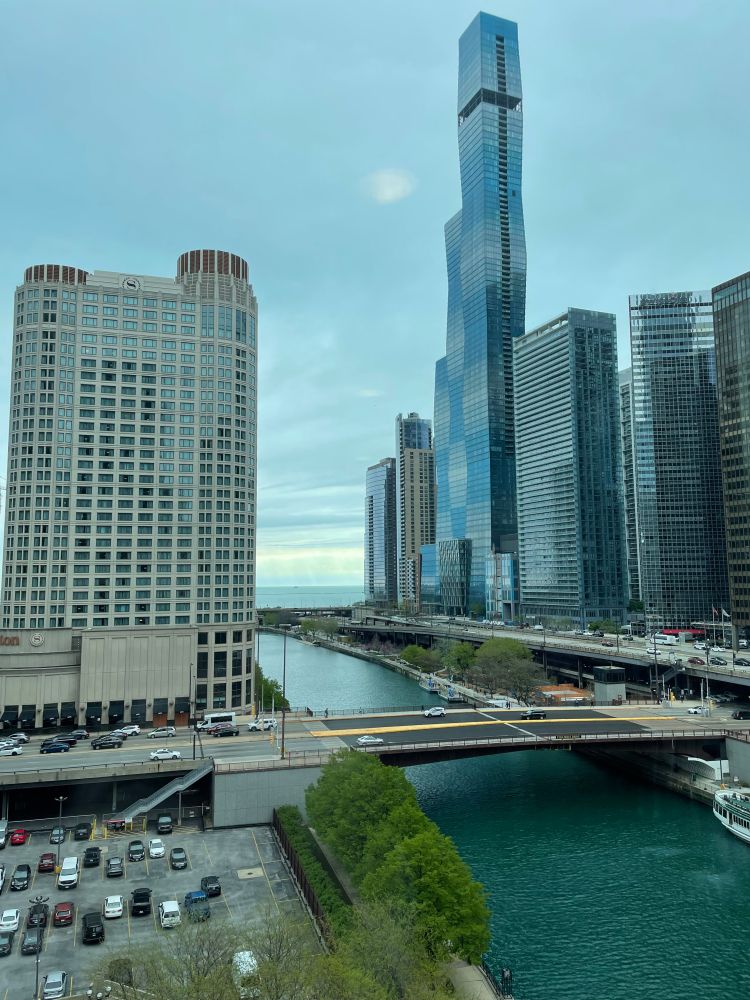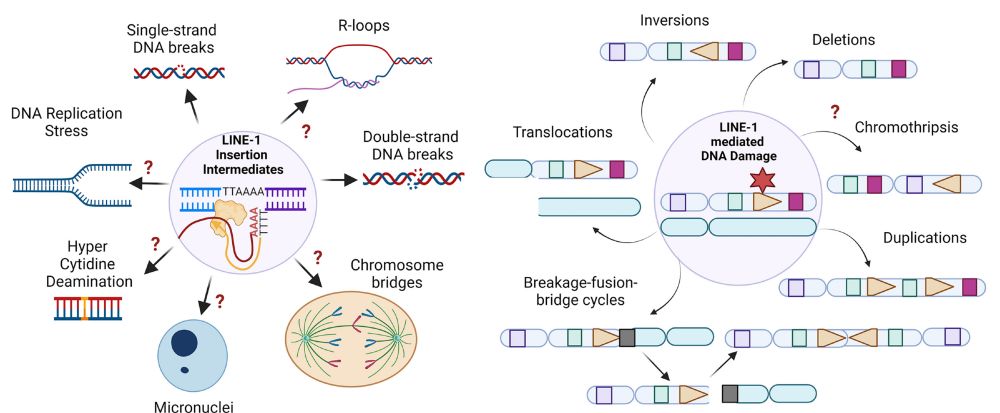Carlos Mendez-Dorantes, PhD
@carlosmendezphd.bsky.social
Pinned

Chromosomal rearrangements and instability caused by the LINE-1 retrotransposon
www.biorxiv.org
Check out our latest pre-print: we show that the LINE-1 retrotransposon is a potent source of chromosomal rearrangements and instability in addition to insertional mutagenesis using shotgun and long-read WGS.
www.biorxiv.org/content/10.1...
www.biorxiv.org/content/10.1...
Reposted by Carlos Mendez-Dorantes, PhD
Check out our pre-print: We show that L1 insertion intermediates can recombine with one another or with DNA breaks to form genome rearrangements, highlighting the risk of L1 retrotransposition generating substrates for aberrant recombination and genome instability.
www.biorxiv.org/content/10.1...
www.biorxiv.org/content/10.1...

L1 insertion intermediates recombine with one another or with DNA breaks to form genome rearrangements
LINE-1 retrotransposition is common in human cancers and rearrangements at insertion sites can contribute to cancer-driving oncogene amplifications and promote genome instability. However, the mechani...
www.biorxiv.org
October 3, 2025 at 7:06 PM
Reposted by Carlos Mendez-Dorantes, PhD
L1 insertion intermediates recombine with one another or with DNA breaks to form genome rearrangements https://www.biorxiv.org/content/10.1101/2025.09.17.676864v1
September 19, 2025 at 12:18 AM
L1 insertion intermediates recombine with one another or with DNA breaks to form genome rearrangements https://www.biorxiv.org/content/10.1101/2025.09.17.676864v1
Reposted by Carlos Mendez-Dorantes, PhD
L1 insertion intermediates recombine with one another or with DNA breaks to form genome rearrangements https://www.biorxiv.org/content/10.1101/2025.09.17.676864v1
September 19, 2025 at 12:18 AM
L1 insertion intermediates recombine with one another or with DNA breaks to form genome rearrangements https://www.biorxiv.org/content/10.1101/2025.09.17.676864v1
Check out our pre-print: We show that L1 insertion intermediates can recombine with one another or with DNA breaks to form genome rearrangements, highlighting the risk of L1 retrotransposition generating substrates for aberrant recombination and genome instability.
www.biorxiv.org/content/10.1...
www.biorxiv.org/content/10.1...

L1 insertion intermediates recombine with one another or with DNA breaks to form genome rearrangements
LINE-1 retrotransposition is common in human cancers and rearrangements at insertion sites can contribute to cancer-driving oncogene amplifications and promote genome instability. However, the mechani...
www.biorxiv.org
September 19, 2025 at 4:36 PM
Check out our pre-print: We show that L1 insertion intermediates can recombine with one another or with DNA breaks to form genome rearrangements, highlighting the risk of L1 retrotransposition generating substrates for aberrant recombination and genome instability.
www.biorxiv.org/content/10.1...
www.biorxiv.org/content/10.1...
Reposted by Carlos Mendez-Dorantes, PhD
Check out Dr. Mendez-Dorantes' recent preprint for more details on his exciting research! www.biorxiv.org/content/10.1... 42/

Chromosomal rearrangements and instability caused by the LINE-1 retrotransposon
LINE-1 (L1) retrotransposition is widespread in many cancers, especially those with a high burden of chromosomal rearrangements. However, whether and to what degree L1 activity directly impacts genome...
www.biorxiv.org
May 9, 2025 at 2:41 PM
Check out Dr. Mendez-Dorantes' recent preprint for more details on his exciting research! www.biorxiv.org/content/10.1... 42/
Reposted by Carlos Mendez-Dorantes, PhD
Dr. Carlos Mendez-Dorantes @carlosmendezphd.bsky.social from Dr. Kathleen Burns' lab @danafarber.bsky.social is telling us about the LINE-1 retrotransposon and its causal role in genome instability and chromosomal rearrangements in a wide variety of cancers. 41/
May 9, 2025 at 2:41 PM
Dr. Carlos Mendez-Dorantes @carlosmendezphd.bsky.social from Dr. Kathleen Burns' lab @danafarber.bsky.social is telling us about the LINE-1 retrotransposon and its causal role in genome instability and chromosomal rearrangements in a wide variety of cancers. 41/
Reposted by Carlos Mendez-Dorantes, PhD
It is a cloudy day in Chicago, but the science is shining here inside the Gleacher Center at the University of Chicago at the 2025 JCC Annual Symposium.
First up this morning: science talks from our 3rd year JCC Fellows ... buckle up!
1 / a lot
First up this morning: science talks from our 3rd year JCC Fellows ... buckle up!
1 / a lot

May 8, 2025 at 1:59 PM
It is a cloudy day in Chicago, but the science is shining here inside the Gleacher Center at the University of Chicago at the 2025 JCC Annual Symposium.
First up this morning: science talks from our 3rd year JCC Fellows ... buckle up!
1 / a lot
First up this morning: science talks from our 3rd year JCC Fellows ... buckle up!
1 / a lot
Reposted by Carlos Mendez-Dorantes, PhD
LINE-1 retrotransposons drive genomic instability and immune activation in cancer. In this review, Mendez-Dorantes and Burns discuss their molecular mechanisms, genomic consequences, and diagnostic and therapeutic targetability.
Read more here:
➡️ tinyurl.com/genesdev351051
Read more here:
➡️ tinyurl.com/genesdev351051

January 10, 2024 at 10:51 PM
LINE-1 retrotransposons drive genomic instability and immune activation in cancer. In this review, Mendez-Dorantes and Burns discuss their molecular mechanisms, genomic consequences, and diagnostic and therapeutic targetability.
Read more here:
➡️ tinyurl.com/genesdev351051
Read more here:
➡️ tinyurl.com/genesdev351051
Reposted by Carlos Mendez-Dorantes, PhD
Congrats @carlosmendezphd.bsky.social!!!
Check out our latest pre-print: we show that the LINE-1 retrotransposon is a potent source of chromosomal rearrangements and instability in addition to insertional mutagenesis using shotgun and long-read WGS.
www.biorxiv.org/content/10.1...
www.biorxiv.org/content/10.1...

Chromosomal rearrangements and instability caused by the LINE-1 retrotransposon
www.biorxiv.org
January 3, 2025 at 2:28 PM
Congrats @carlosmendezphd.bsky.social!!!
Reposted by Carlos Mendez-Dorantes, PhD
Chromosomal rearrangements and instability caused by the LINE-1 retrotransposon
www.biorxiv.org/content/10.1...
www.biorxiv.org/content/10.1...

Chromosomal rearrangements and instability caused by the LINE-1 retrotransposon
LINE-1 (L1) retrotransposition is widespread in many cancers, especially those with a high burden of chromosomal rearrangements. However, whether and to what degree L1 activity directly impacts genome...
www.biorxiv.org
December 18, 2024 at 9:07 PM
Chromosomal rearrangements and instability caused by the LINE-1 retrotransposon
www.biorxiv.org/content/10.1...
www.biorxiv.org/content/10.1...
Reposted by Carlos Mendez-Dorantes, PhD
Chromosomal rearrangements and instability caused by the LINE-1 retrotransposon https://www.biorxiv.org/content/10.1101/2024.12.14.628481v1
December 18, 2024 at 7:37 AM
Chromosomal rearrangements and instability caused by the LINE-1 retrotransposon https://www.biorxiv.org/content/10.1101/2024.12.14.628481v1
Reposted by Carlos Mendez-Dorantes, PhD
Chromosomal rearrangements and instability caused by the LINE-1 retrotransposon https://www.biorxiv.org/content/10.1101/2024.12.14.628481v1
December 18, 2024 at 7:37 AM
Chromosomal rearrangements and instability caused by the LINE-1 retrotransposon https://www.biorxiv.org/content/10.1101/2024.12.14.628481v1
Check out our latest pre-print: we show that the LINE-1 retrotransposon is a potent source of chromosomal rearrangements and instability in addition to insertional mutagenesis using shotgun and long-read WGS.
www.biorxiv.org/content/10.1...
www.biorxiv.org/content/10.1...

Chromosomal rearrangements and instability caused by the LINE-1 retrotransposon
www.biorxiv.org
December 19, 2024 at 9:47 PM
Check out our latest pre-print: we show that the LINE-1 retrotransposon is a potent source of chromosomal rearrangements and instability in addition to insertional mutagenesis using shotgun and long-read WGS.
www.biorxiv.org/content/10.1...
www.biorxiv.org/content/10.1...

